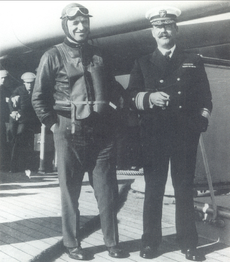- Montgomery M. Taylor
-
Montgomery M. Taylor
Rear Admiral Montgomery M. Taylor with humorist Will Rogers.Born October 13, 1869
Washington, D.C.Died October 21, 1952 (aged 83)
Bethesda Naval Medical Center, Bethesda, MarylandPlace of burial Arlington National Cemetery Allegiance United States of America Service/branch United States Navy Years of service 1890-1936 Rank  Admiral
AdmiralCommands held United States Asiatic Fleet
Scouting FleetBattles/wars Spanish-American War
World War IRelations Zachary Taylor (great-uncle)
Montgomery C. Meigs (grandfather)
Montgomery Meigs (cousin)Montgomery Meigs Taylor (October 13, 1869 – October 21, 1952) was an admiral in the United States Navy who served as Commander in Chief, United States Asiatic Fleet (CINCAF) from 1931 to 1933.
Military career
Taylor was born on October 13, 1869 in Washington, D.C. to Joseph Hancock and Mary Meigs Taylor.[1] After graduating from the United States Naval Academy in 1890, where he had played halfback on the football team, his first assignment was aboard the USS Baltimore (C-3), receiving his commission as an ensign in 1892.[1]
During the Spanish-American War, Taylor served as a battery commander aboard the USS Olympia (C-6), Admiral George Dewey's flagship, and took part in the Battle of Manila Bay.[1]
Following the war, he was the first commander of the USS Hopkins (DD-6) from 1903 to 1905, followed by command of the 2nd Torpedo Flotilla from 1905 to 1906, and the receiving ship USS Wabash from 1906 to 1908.[1]
He served as executive officer of the USS Salem (CL-3) from 1908 to 1909, and the USS Milwaukee (C-21) from 1909 to 1910. He was then given command of the USS Petrel (PG-2) (1910–1911), followed by assignment as aide to Commandant, Navy Yard, New York City from 1911 to 1913.[1] He return to command on the USS Buffalo from 1913 to 1915, then attended the Naval War College, graduating in 1916, whereupon he was given command of the USS Maine (BB-10).[1] In 1917, he was attached to the Office of Naval Operations at the Navy Department, followed the next year with command of the USS Florida (BB-30), operating with the British Grand Fleet during World War I, for which he was awarded the Navy Distinguished Service Medal.[1]
After the war, he returned to the staff of the Naval War College from 1919 to 1921.[1] He was next assigned as a member of the Naval Examining and Retiring Board, and later that year he was appointed commander of the Control Force, and as commander of all Atlantic submarines.[1] He was promoted to Rear Admiral in 1922.[1] Taylor was director of fleet training for the Navy Department from 1925 to 1927 and afterward commanded the Third Battleship Division of the Battle Fleet. Promoted to Vice Admiral, he was given command of the Scouting Fleet.[1]
He returned to Washington as chief of the War Plans Division of the Office of the Chief of Naval Operations from 1929 until he became Commander-in-Chief of the Asiatic Fleet in 1931. In 1936 he was appointed to serve on the United States Maritime Commission. He retired from the Navy on November 1, 1936.[1]
He died at Bethesda Naval Medical Center of a stroke on October 21, 1952 and was buried in Arlington National Cemetery. Taylor never married.[1]
His awards and medals included the Dewey Medal, Spanish Campaign Medal, Philippine Campaign Medal, World War I Victory Medal, and the Navy Distinguished Service Medal.[1]
References
Categories:- 1869 births
- 1952 deaths
- People from Washington, D.C.
- United States Naval Academy alumni
- American military personnel of the Spanish–American War
- American military personnel of World War I
- United States Navy admirals
- Burials at Arlington National Cemetery
Wikimedia Foundation. 2010.

